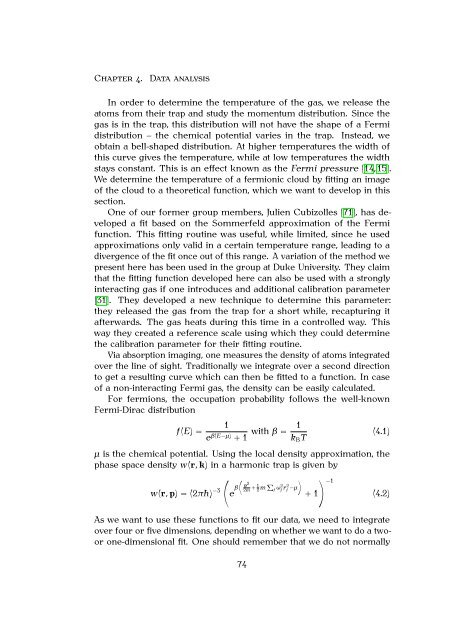Martin Teichmann Atomes de lithium-6 ultra froids dans la ... - TEL
Martin Teichmann Atomes de lithium-6 ultra froids dans la ... - TEL
Martin Teichmann Atomes de lithium-6 ultra froids dans la ... - TEL
Create successful ePaper yourself
Turn your PDF publications into a flip-book with our unique Google optimized e-Paper software.
CHAPTER 4. DATA ANALYSIS<br />
In or<strong>de</strong>r to <strong>de</strong>termine the temperature of the gas, we release the<br />
atoms from their trap and study the momentum distribution. Since the<br />
gas is in the trap, this distribution will not have the shape of a Fermi<br />
distribution – the chemical potential varies in the trap. Instead, we<br />
obtain a bell-shaped distribution. At higher temperatures the width of<br />
this curve gives the temperature, while at low temperatures the width<br />
stays constant. This is an effect known as the Fermi pressure [14, 15].<br />
We <strong>de</strong>termine the temperature of a fermionic cloud by fitting an image<br />
of the cloud to a theoretical function, which we want to <strong>de</strong>velop in this<br />
section.<br />
One of our former group members, Julien Cubizolles [71], has <strong>de</strong>veloped<br />
a fit based on the Sommerfeld approximation of the Fermi<br />
function. This fitting routine was useful, while limited, since he used<br />
approximations only valid in a certain temperature range, leading to a<br />
divergence of the fit once out of this range. A variation of the method we<br />
present here has been used in the group at Duke University. They c<strong>la</strong>im<br />
that the fitting function <strong>de</strong>veloped here can also be used with a strongly<br />
interacting gas if one introduces and additional calibration parameter<br />
[31]. They <strong>de</strong>veloped a new technique to <strong>de</strong>termine this parameter:<br />
they released the gas from the trap for a short while, recapturing it<br />
afterwards. The gas heats during this time in a controlled way. This<br />
way they created a reference scale using which they could <strong>de</strong>termine<br />
the calibration parameter for their fitting routine.<br />
Via absorption imaging, one measures the <strong>de</strong>nsity of atoms integrated<br />
over the line of sight. Traditionally we integrate over a second direction<br />
to get a resulting curve which can then be fitted to a function. In case<br />
of a non-interacting Fermi gas, the <strong>de</strong>nsity can be easily calcu<strong>la</strong>ted.<br />
For fermions, the occupation probability follows the well-known<br />
Fermi-Dirac distribution<br />
f(E) =<br />
1<br />
e β(E−µ) + 1<br />
with β = 1<br />
kBT<br />
(4.1)<br />
µ is the chemical potential. Using the local <strong>de</strong>nsity approximation, the<br />
phase space <strong>de</strong>nsity w(r, k) in a harmonic trap is given by<br />
w(r, p) = (2π¯h) −3<br />
�<br />
e β<br />
�<br />
p2 2m + 1 �<br />
2 m j ω2 j r2 j −µ<br />
�<br />
+ 1<br />
� −1<br />
(4.2)<br />
As we want to use these functions to fit our data, we need to integrate<br />
over four or five dimensions, <strong>de</strong>pending on whether we want to do a twoor<br />
one-dimensional fit. One should remember that we do not normally<br />
74

















